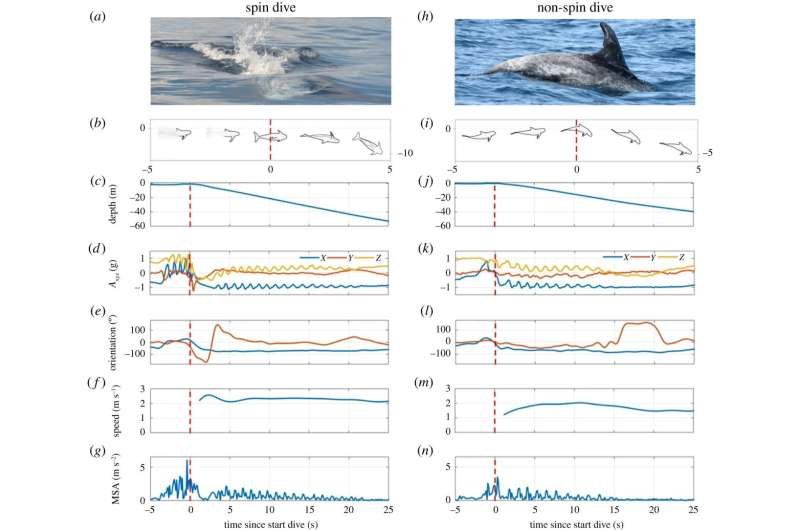Figure 1. Fine-scale movement kinematics at the onset of spin and non-spin foraging dives. (a–g) Show a typical example of a spin dive and (h–n) of a non-spin dive (also known as ‘arch-out dive’). Energetic spin (a) versus slow body arch (h) at the onset of a spin and a non-spin dive. (b) and (i): graphic representation of body orientation and depth from 5 s before to 5 s after the onset of the dive (indicated by the red vertical dashed line at t = 0). (c–g) and (j–n): movement kinematics from 5 s before to 25 s after the onset of the dive at t = 0. (c,j) Depth of the individual animal; (d,k) acceleration (Axyz) along the three body axes (proxy for fluking), gliding initiated at 21 s (d) and 14 s (k); (e,l) change in body orientation, by pitch (blue) and lateral rotation (red); (f,m) forward speed; (g,n) MSA (proxy for energetic expenditure). In the spin dive, surface acceleration from strong fluking effort (onset at t = −4 s) is followed by a right-sided rotation (e; onset at t = −1 s), resulting in rapid descent (c,f). The individual performs a full spin (360° rotation, t = −1 to t = +8 s). Surface acceleration (k,n) and strong axial rotation (l) are absent in the first seconds of non-spin dives. Credit: DOI: 10.1098/rsos.202320
A team of researchers affiliated with multiple institutions in the Netherlands and one in the U.S. has found that Risso's dolphins use a special type of spin move to conserve energy and oxygen when they dive deep for prey. In their paper published in the journal Royal Society Open Science, the group describes their study of the underwater mammals living near Portugal's Terceira Island.
Prior research has shown that some toothed whales dive to great depths, sometimes measured in kilometers, to hunt for prey. So they have developed specialized diving strategies that optimize energy and oxygen expenditure with the amount of food they get through their efforts. In this new effort, the researchers have found that Risso's dolphins have also developed a specialized technique to drill down to deeper, more fertile water, while conserving energy and oxygen. The research effort involved fitting seven dolphins with biologgers, which is hardware capable of recording movements and sound.
The researchers found that when instigating a deep dive, the dolphins first started with strong fin strokes that, in addition to propelling them downward, also spun their bodies in the water, almost always to the right. They also exhaled strongly, which the researchers believe resulted in reduced buoyancy. The dolphins then adjusted their diving angle to about 60 degrees while simultaneously pushing themselves into a high-speed twisting descent. That was followed up by a rotating free fall, bringing the dolphin to a deeper part of the sea with more abundant prey, such as fish, squid or crustaceans. The researchers found that the dolphins descended at approximately 9 kph to 426 meters on average, and that each dive lasted on average 10 minutes. The researchers also found that the dolphins did not start using their echolocation abilities until they had reached their destination—a finding that suggests the dolphins were planning their dives.
In watching their behavior on shallow dives, the researchers found no evidence of twisting or turning as the dolphins descended, which made for much slower speeds. They also began using their echolocation tools right away. Interestingly, the dive duration was approximately the same for both types of dives.
More information: Fleur Visser et al, Risso's dolphins perform spin dives to target deep-dwelling prey, Royal Society Open Science (2021). DOI: 10.1098/rsos.202320
Journal information: Royal Society Open Science
© 2021 Science X Network























